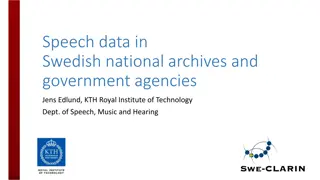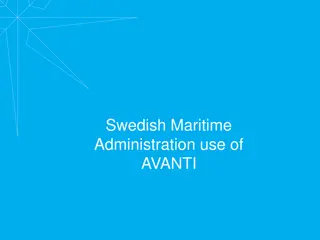The Swedish Higher Education System Overview
The Swedish higher education sector comprises universities, university colleges, art colleges, and semi-private institutions. There are 14 universities and University colleges have the right to award undergraduate and professional degrees. Art colleges specialize in various art forms and have the authority to grant bachelor's and master's degrees in art. University autonomy and academic freedom are crucial elements in the governance of educational institutions.
Download Presentation

Please find below an Image/Link to download the presentation.
The content on the website is provided AS IS for your information and personal use only. It may not be sold, licensed, or shared on other websites without obtaining consent from the author.If you encounter any issues during the download, it is possible that the publisher has removed the file from their server.
You are allowed to download the files provided on this website for personal or commercial use, subject to the condition that they are used lawfully. All files are the property of their respective owners.
The content on the website is provided AS IS for your information and personal use only. It may not be sold, licensed, or shared on other websites without obtaining consent from the author.
E N D
Presentation Transcript
The Swedish Higher Education Sector April 2017 KTH Lennart St hle
What is a University? The Guild nature of mediveal European universities: The word university universitas in mediveal latin means guild and a correct translation of universitas magistrorum et scolarium is the guild of teachers and students . Early universities up to 1800 were education institutions. Research is introduced relatively late in the university system. Is the 200 year Berlin contract of freedom of speech, teaching and research is it thereatend by the moves toward more autonomy? 2024-11-25
University autonomy academic freedom University autonomy refers to the governace of the institution. In the European debate it ususally refers to autonomy from the state. Academic freedom refers to postion of the individual teacher and or resercher with in the system. An autonomus institution can threaten the academic freedom but so can also centrally governed institution. 2024-11-25
The Swedish higher education sector 14 Universities 14 UniversityColleges 4 Art Colleges 13 Semi-private institutions There is no formal accreditation of institutions. The government decides about the foundation of state institutions. The Swedish Higher Education Authority decides about accreditation of degrees. 2024-11-25
Higher education institutions - universities 14 universities A university is a HEI that has been given the right to award doctoral degrees in all subjects and at all faculties. A university has also consequently the right to award bachelors and masters degrees in all subjects and at all faculties. Universities have also the right to award professional degrees according the decision of The Swedish National Agency for Higher Education 2024-11-25
University colleges 14 University colleges (UC) A University college is a HEI that has been given the right to award degrees a undergraduate level. UC s have also the right to award professional degrees according the decision of The Swedish Higher Education Authority. They have also the possibility to award PhD s within a defined area of research. 2024-11-25
Colleges of art 4 University colleges of Art. All situated in Stockholm Speccialised in one art form each: dance, music, paniting, opera, crafts / design, and film / radio/ television production They have all right to award a Bachelors and a Masters degree in art Small in number of students 600 - 35 Art education is also carried out at some universities and university colleges. 2024-11-25
Students The Sector is still growing when it comes to number of students, staff and economy. 357 000 students at first and second cycles programmes and 70 000 degrees 19 000 students at third cycle (PhD programmes) and 3 300 2 500 PhD degrees 2024-11-25
Semi private instituions 13 institutions of varied size Two of them former state institutions: Chalmers Institute of Technolgy and The University College of J nk ping One: Stockholm School of Business is the oldest independent HE institution 10 rather small institutions: 2 nursing schools (belonging to The Red Cross and a private hospital, 1 design school and 7 schools closely connetected to religious (Christian) churches. They have the right to award specific degrees according to the Higher Education Ordinance after application to the goverment and accreditation. 2024-11-25
Staff Research and teaching staff: 29 200 5 089 professors - 25% vomen 8 581 senior lecturers - 46% women 2024-11-25
Students 343 344 students - 60% women, 40% men. 18 433 PhD students - 47% women, 53% men. 2024-11-25
The Bolognadeclaration The degree structure should be transparent and internationally comparable The degree struture should be divided in two/ three cycles ECTS should be introduced to enhance student mobility Obstsacles for mobility of students and staff should e removed The European cooperation in quality assurance should increase The European dimension in Higher Education 2024-11-25
First cycle: University Diploma (120 ECTS) University Diploma In Fine Arts Bachelor (180 ECTS) Bachelor in Fine Arts 20 Professional Degrees (120 180 ECTS) 2024-11-25
Second cycle: Master (60 ECTS) Master (60 ECTS) in Fine Arts Master (120 ECTS) Master (120 ECTS) in Fine Arts 15 Professional Degrees (60 and 120 ECTS) 2024-11-25
Third cycle Licentiate degree (2 years) Doctoral degree (4 years) 2024-11-25
The degree system and Bologna process 2024-11-25
Every degree has a standard, decided by thr government in an annex to the Higher Education Ordinance. The standard consists of - a general discription Scope - Outcomes - Knowledge and understanding - Competence and skills - Judgement and approach - Independent project (degree project) 2024-11-25
The degree diploma should contain: The name of the degree The level of the degree The courses The name of the Higher Education Institution where the courses have been examined A Diploma supplement should be attached to the degree diploma 2024-11-25
Higher education degrees 46 887 General degrees (Diploma, Bachelor and Master) 1 815Diploma 56% women - 44% men 28 475 Bachelor 64% women - 36% men 16 607 Master 47% women -53% men 972 Art degrees 59% women - 41% me 33 014 Professional degrees 67% women 33% men 2 835 PhD degrees 47% women 53% men 2024-11-25
Governance state institutions Higher Education Act (decided by the parliamnet) Higher Education Ordinance (decideed by the government) 2024-11-25
Funding state institutions It is the parliament, after proposal from the government (MOE), who decides about the budget to the institutions. Student numbers and performance determine funding for undergraduate teaching. The oucomes of quality evaluations are also an important factor. Fundin postgraduate programmes and research performanceindicators: publications, external funding. 2024-11-25
Governance governing body All institutions must have a governing board of 15 persons: 8 members appointed by the government after suggestion form the HEI (rector) 3 representatives of the academic staff 3 representatives of the students and The rector 2024-11-25
The governing board decides about: The over all budget of the institution The organisation Budget proposals to the government The annual report and Proposal for the position as rector The board has no influence in academic matters 2024-11-25
Governance semi private institutions No regulations from the state except for admission rules. Annual contract with the state about their education (according to HEO) and the reimbursement for their accreditated education. 2024-11-25
Quality Assurance Why? Increasing competition nationally and internationally Expectations from stakeholders The rapid growth of Higher Education and investment in HE demands that quality must be shown International mobility and recognition of degrees 2024-11-25
Quality Quality of a course Quality of a programme Quality of a degree Quality of an institution HOW CAN YOU PROVE QUALITY? Quality assurance is a generic term in higher education which lends itself to many interpretations: It is not possible to use one definition to cover all circumstances. 2024-11-25
It is you as a HEI that have the responsibility to develop your own quality assurance system. To prove quality you must show that you have developed an internal quality assurance process. You must show that your institution contiuning work with quality assurance questions and That this work is developed at all levels in the institution. 2024-11-25
External Quality asuurance Carried out by an external independent body Diffirent ways to organise the quality assurance nationally. In Sweden the government has given the task to the Swedish Authority of Higher Education. 2024-11-25
The Swedish case Four pahses/ cycles of QA. QA is focussed on education and teaching. The institutions do carry out evaluation of research and administration. A modern quality assurance system includes all aspects of the operations of the institution. 2024-11-25
First phase Quality assurance and evaluation was introduced in 1993. The office of the University Chancellor (UC) was given the task. Evaluation of quality assurance systems of the institutions. - Self evaluation - External panel with students - Written report to the UC with recommendation. - Decsion by the UC: acceptable or non acceptable. Good examples. 2024-11-25
Second Phase QA system based on accreditation and control. The system looked into the prerequisites and processes: - Teacher competence including gender composition - Physical facilities - Internationalisation - Teaching methods Thematic studies: internationalisation, equuality, student participation etc. 2024-11-25
Important components: - Self evaluation - Peer review - Site visits with interviews - Written report to the UC If quality was considered to be in danger or insuffcient the right to award a degree could be withdrawn. 2024-11-25
Third phase Three main components: Granting degree awarding powers (accreditation) Evaluation of study programs and courses leading up to a degree. Evaluation of PhD programs should be included. 2024-11-25
Peer review with assessment panels: Subject experts Students Representatives from working life 2024-11-25
The students degree projects Self-evaluations of higher education institutions Student experiences Questionnaires sent to alumni Web based interviews (Site visits) 2024-11-25
The result of the assesment: The panel of assessors should give an overall appraisal of the study programme s quality on a three-level scale: Very high quality High quality Inadequate quality The formal decision is made by the University Chancellor. 2024-11-25
If the assessment of a study programme reveals inadequate quality, the HEIs right to award the degree is questioned. Follow-up after one year. If no improvement The Agency withdraws the HEIs right to award the degree. 2024-11-25
Fourth phase Examination of the quality assurance system for education Accreditation of new programmes Review of existing programmes Thematic reviews Proposal from the government: Evaluation of research 2024-11-25


























